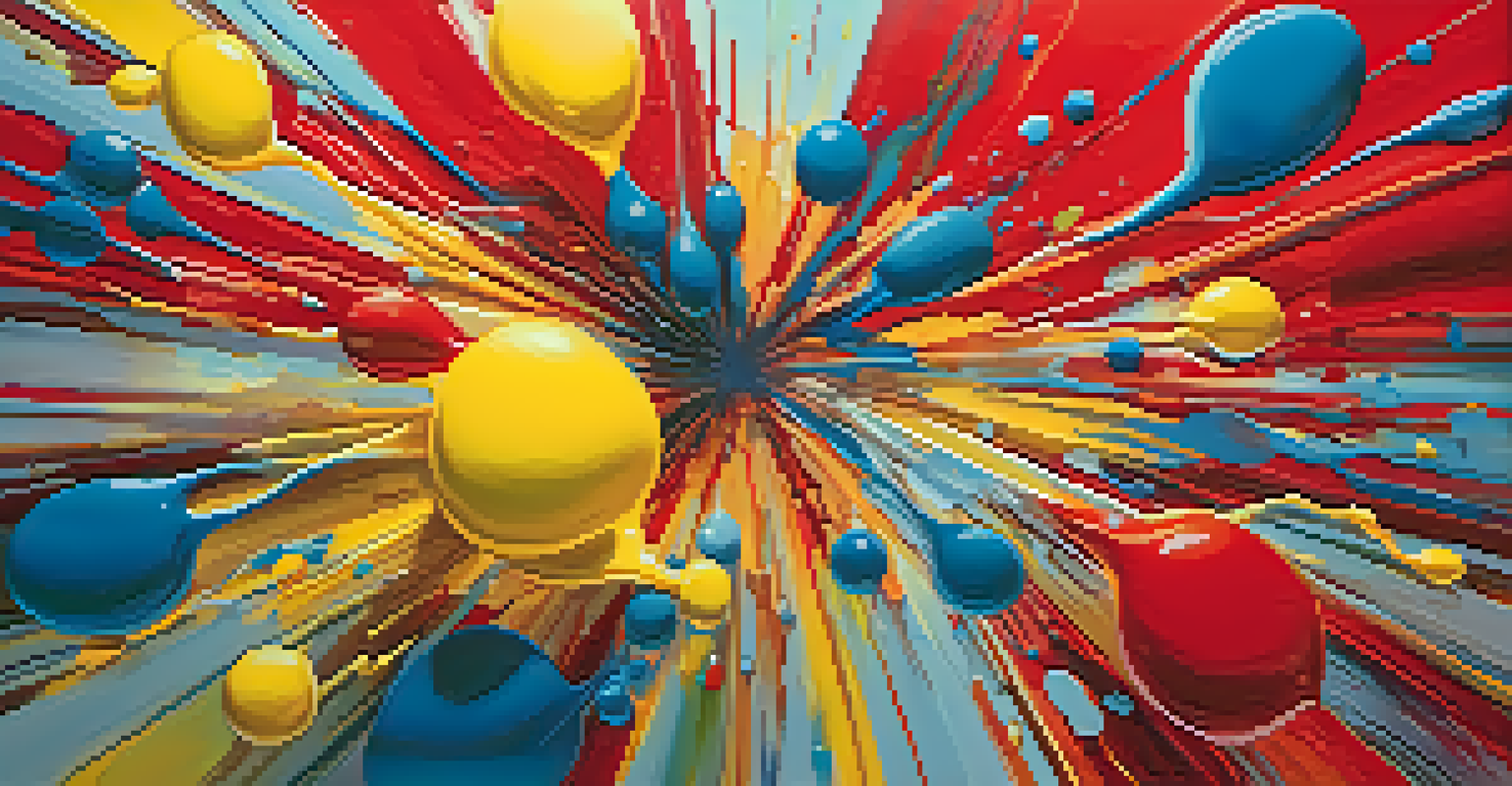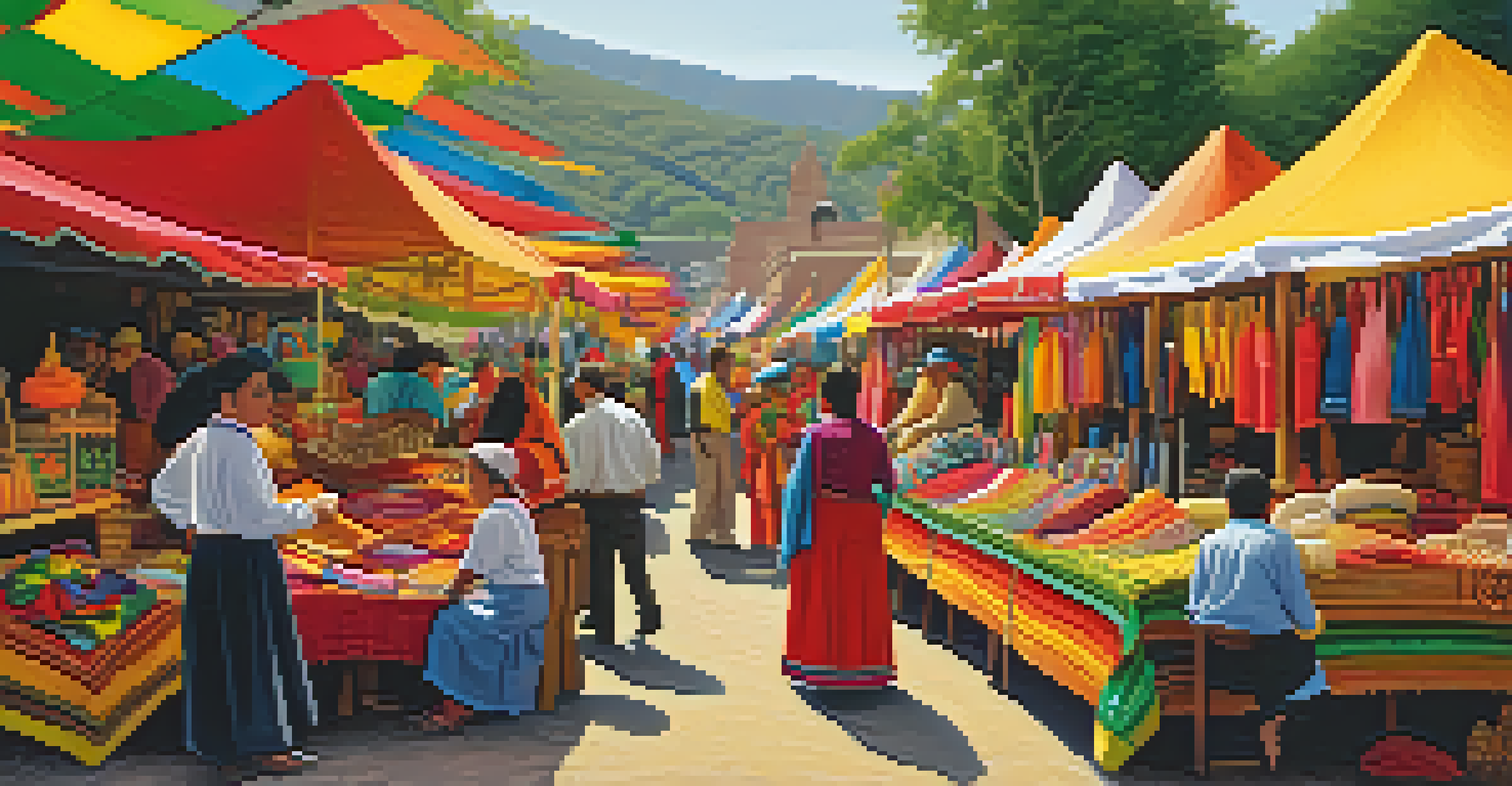The Use of Color in Painting to Reflect Cultural Emotions

The Emotional Power of Color in Art
Color is more than just a visual element; it carries deep emotional weight. Artists often choose specific colors to evoke feelings and set the tone of their work. For instance, warm colors like red and orange can create feelings of passion and warmth, while cooler colors like blue and green tend to evoke calmness or sadness.
Color is the keyboard, the eyes are the harmonies, the soul is the piano with many strings.
This emotional resonance of color varies across cultures, as different societies may associate colors with unique meanings. Understanding these associations can enrich our appreciation of art. For example, in many Western cultures, white symbolizes purity, while in some Eastern cultures, it represents mourning.
Ultimately, the emotional power of color allows artists to communicate complex feelings that might be difficult to express with words alone. This ability to convey emotion through color is a fundamental aspect of painting that transcends cultural boundaries.
Cultural Symbolism and Color Choices
Colors carry different symbolic meanings across cultures, influencing how they are used in art. For instance, red often symbolizes luck and happiness in Chinese culture, making it a popular choice for celebratory paintings. Conversely, in some contexts, red can signify danger or aggression, showcasing the dual nature of color symbolism.

Artists often draw from their cultural backgrounds to select colors that resonate with their audience. By incorporating culturally significant colors into their work, they create a connection that speaks to shared experiences and emotions. This cultural lens can enrich the viewer's understanding and appreciation of the artwork.
Color Evokes Deep Emotions
Artists use color to communicate complex feelings, allowing viewers to connect with the emotional depth of their work.
Moreover, the interplay of colors can tell a story or convey a message that reflects the artist's cultural heritage. For example, the use of earth tones in Indigenous art often symbolizes a deep connection to nature and ancestral lands, highlighting the importance of the environment within that cultural context.
Color in Traditional vs. Contemporary Art
Traditional art forms often utilize color in ways that reflect historical and cultural significance. For instance, ancient Egyptian paintings employed a strict palette that conveyed status and spirituality, using colors like gold to symbolize divinity. These color choices were not arbitrary; they were steeped in cultural beliefs and rituals.
Colors, like features, follow the changes of the emotions.
In contrast, contemporary artists may experiment with color in more abstract or unexpected ways. This shift allows for personal expression and a broader interpretation of cultural emotions. An artist today might use neon colors to evoke feelings of chaos or modernity, challenging the viewer's perceptions of cultural norms.
This evolution in the use of color highlights the dynamic relationship between culture and art. As societies change, so too do their artistic expressions, allowing for new interpretations of color and emotion that reflect current experiences.
The Role of Color in Cultural Identity
Color can play a vital role in shaping cultural identity, influencing how communities express themselves through art. For instance, the vibrant colors of Mexican folk art often reflect the richness of its cultural heritage, celebrating traditions and values. These colors tell stories of history, community, and identity, making them an integral part of cultural expression.
Artists from marginalized communities may use color to reclaim their narratives and assert their identities. By choosing specific colors that resonate with their experiences, they challenge stereotypes and create a platform for dialogue. This reclamation of color can empower and validate cultural identities in ways that resonate deeply with viewers.
Cultural Significance of Colors
Colors carry different meanings across cultures, influencing artistic choices and enriching the viewer's understanding of the artwork.
In this context, color becomes a tool for cultural storytelling, allowing artists to weave their personal and communal histories into their work. Whether through bold, expressive strokes or subtle, muted tones, the colors used in art can encapsulate the essence of a culture and its people.
Psychological Effects of Color in Cultural Contexts
The psychology of color is a fascinating field that explores how colors affect our emotions and behaviors. In cultural contexts, these psychological effects can vary widely. For instance, while blue is often associated with tranquility in many Western cultures, it may evoke feelings of sadness in others, demonstrating the complexity of color perception.
Artists can leverage these psychological effects to communicate specific emotions or ideas. By understanding how their audience perceives color, they can create artwork that resonates on a deeper emotional level. This understanding can enhance the impact of their work, making it a powerful tool for cultural expression.
As we navigate the visual world, the psychological implications of color remind us of the intricate connections between art, emotion, and culture. Artists who are aware of these dynamics can craft pieces that not only reflect their cultural narratives but also engage viewers on a psychological level.
Color in Global Art Movements
Throughout history, various art movements have embraced color as a central element of expression. The Impressionists, for example, revolutionized the use of color in painting by focusing on the effects of light and atmosphere. Their innovative techniques invited viewers to experience the world in new ways, highlighting the emotional responses elicited by color.
Similarly, movements like Fauvism celebrated bold, non-representational colors to express emotional depth. Artists like Henri Matisse used color as a primary means of conveying feelings, emphasizing that the emotional experience of art often transcends realistic representation.
Evolution of Color in Art
The use of color in art is continuously evolving, blending traditional palettes with modern techniques to reflect contemporary cultural identities.
These global movements show how color serves as a universal language in art that transcends cultural boundaries. By exploring the emotional possibilities of color, artists from different backgrounds contribute to a shared understanding of cultural emotions, creating a rich tapestry of artistic expression.
The Future of Color in Cultural Art
As we look to the future, the use of color in cultural art continues to evolve. Artists are increasingly blending traditional color palettes with modern techniques to create innovative works that reflect contemporary issues and emotions. This fusion allows for a dynamic exploration of cultural identity and expression.
Moreover, the rise of digital art has expanded the possibilities for color use, enabling artists to experiment with vibrant hues and textures that were previously unattainable. This accessibility offers new avenues for cultural storytelling through color, allowing artists to engage a global audience.

As color remains a pivotal element in art, its role in reflecting cultural emotions will only grow. The future promises exciting developments, as artists continue to push the boundaries of color and explore its profound impact on our understanding of culture and emotion.